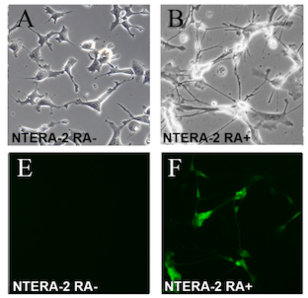NTERA-2

The NTERA-2 (also designated NTERA2/D1, NTERA2, or NT2) cell line is a clonally derived, pluripotent human embryonal carcinoma cell line.[1]
Characteristics
NTERA-2 cells exhibit biochemical and developmental properties similar to the cells of the early embryo, and can be used to study the early stages of human neurogenesis. The cells exhibit a high nucleo-cytoplasmic ratio, prominent nucleoli, and the expression of the glycolipid antigen SSEA-3. They also express nestin and vimentin, which are found in neuroepithelial precursor cells, as well as microtubule-associated proteins expressed in human neuroepithelium.[2] NTERA-2 cells also accumulate cytoplasmic glycogen.[3]
Differentiation
NTERA-2 cells differentiate when exposed to retinoic acid and lose expression of SSEA-3. Differentiation produces neurons via asymmetric cell division, and these cells form interconnected axon networks and express tetanus toxin receptors and neurofilament proteins.[4] By 10-14 days of exposure to retinoic acid, NTERA-2 cells begin to take on the morphological characteristics of neurons, such as rounded cell bodies and processes.[2] NTERA-2 cells can also produce a small number of oligodendrocyte-type cells, but they cannot differentiate into astrocytes.[5]
Research
Because of their similarity to human embryonic stem cells, NTERA-2 cells are used to study the dopaminergic differentiation of neuronal precursor cells.[6] They have also been proposed as an in vitro test system for developmental neurotoxicity.[7]
History
NTERA-2 cells were originally isolated from a lung metastasis from a 22 year old male patient with primary embryonal carcinoma of the testis. The tumor was xenografted onto a mouse, and from this cells were cloned into the NTERA-2 cell line.[3]
References
- ↑ Lee VM, Andrews PW (1986). "Differentiation of NTERA-2 clonal human embryonal carcinoma cells into neurons involves the induction of all three neurofilament proteins.". J Neurosci 6 (2): 514–21. PMID 2419526.
- ↑ 2.0 2.1 Pleasure SJ, Lee VM (1993). "NTera 2 cells: a human cell line which displays characteristics expected of a human committed neuronal progenitor cell.". J Neurosci Res 35 (6): 585–602. doi:10.1002/jnr.490350603. PMID 8411264.
- ↑ 3.0 3.1 Andrews PW, Damjanov I, Simon D, Banting GS, Carlin C, Dracopoli NC et al. (1984). "Pluripotent embryonal carcinoma clones derived from the human teratocarcinoma cell line Tera-2. Differentiation in vivo and in vitro.". Lab Invest 50 (2): 147–62. PMID 6694356.
- ↑ Andrews PW (1984). "Retinoic acid induces neuronal differentiation of a cloned human embryonal carcinoma cell line in vitro.". Dev Biol 103 (2): 285–93. doi:10.1016/0012-1606(84)90316-6. PMID 6144603.
- ↑ Marchal-Victorion S, Deleyrolle L, De Weille J, Saunier M, Dromard C, Sandillon F et al. (2003). "The human NTERA2 neural cell line generates neurons on growth under neural stem cell conditions and exhibits characteristics of radial glial cells.". Mol Cell Neurosci 24 (1): 198–213. doi:10.1016/s1044-7431(03)00161-1. PMID 14550780.
- ↑ Schwartz CM, Spivak CE, Baker SC, McDaniel TK, Loring JF, Nguyen C et al. (2005). "NTera2: a model system to study dopaminergic differentiation of human embryonic stem cells.". Stem Cells Dev 14 (5): 517–34. doi:10.1089/scd.2005.14.517. PMID 16305337.
- ↑ Stern M, Gierse A, Tan S, Bicker G (2014). "Human Ntera2 cells as a predictive in vitro test system for developmental neurotoxicity.". Arch Toxicol 88 (1): 127–36. doi:10.1007/s00204-013-1098-1. PMID 23917397.